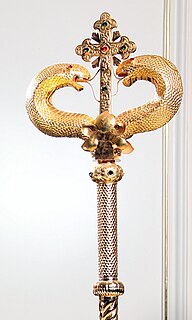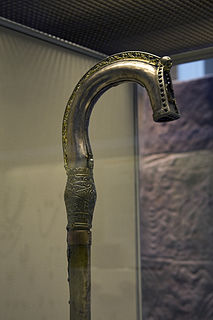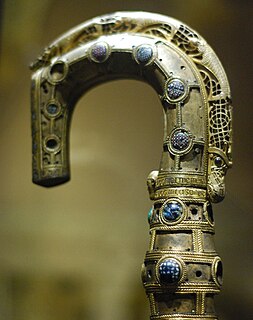 W
WA crosier is a stylized staff that is a symbol of the governing office of a bishop or Apostle and is carried by high-ranking prelates of Roman Catholic, Eastern Catholic, Eastern Orthodox, Oriental Orthodox, and some Anglican, Lutheran, United Methodist and Pentecostal churches.
 W
WThe Clonmacnoise Crozier is a late 11th century Insular crozier associated with the 6th century Clonmacnoise monastery, an important but now ruined ecclesiastical complex south of located Athlone, on the River Shannon in County Offaly, Ireland. Traditionally associated with St. Ciarán of Clonmacnoise, the crozier is thought to have been commissioned by Tigernach Ua Braín, but this is uncertain.
 W
WAn Insular crozier is a type of processional bishop's staff (crozier) produced in Ireland and Scotland between c. 800 and 1200. They can be distinguished from mainland European types by their curved crooks and drop. By the end of the 12th century, production of Irish croziers had largely ended, but examples continued to be reworked and added to throughout the Romanesque and Gothic periods.
 W
WThe Kells crozier or British Museum Crozier is a medieval Irish bishop's staff that has been part of the British Museum's collection since 1859. It is one of just four extant complete examples known from Ireland, although its provenance before it appeared for sale in London in 1850 is lost. It is in poor condition, with much of it ornimentation lost, but is well studied as it is early, and structurally intact.
 W
WThe Lismore Crozier is an Irish Insular type crozier dated to between 1100 and 1113 AD. It consists of a wooden tubular staff lined with copper-alloy plates; embellished with silver, gold, niello and glass; and capped by a crook with a decorative openwork crest.
 W
WThe Prosperous Crozier is an Irish Insular type crozier dating from the late 9th or early 10 century. crozier was found fully intact by turf cutters in 1831 near Prosperous, County Kildare, but did not receive attention from antiquarians until 1851. It is made from copper, zinc, and tin alloy, and contains traces of inscriptions, but they are too worn to read.
 W
WThe River Laune Crozier is a late 11th-century Insular crozier, now at the Archaeology branch of the National Museum of Ireland. The object would have been commissioned as a staff of office for a senior clergyman, most likely a bishop. It consists of a wooden core decorated with fitted bronze and silver metal plates. Although the metalwork is somewhat corroded in parts, it is fully intact and considered one of the finest surviving Irish examples, alongside those found at Clonmacnoise and Lismore.
 W
WSt. Fillan’s Crozier is an 8th century Insular crozier crook traditionally associated with the Irish monk St. Fillan, who lived in the eighth century at Glendochart in Perthshire, central Scotland. Only the crook survives; the staff was lost at an unknown date. Sometime around the late 13th century the crook was encased in the Coigreach, a crosier-shrine of similar size and form built as a protective case for the crook, and made from silver, gold and rock crystal and dates from the late 13th century, with additions from the 14th or 15th centuries. The Coigreach was rediscovered in the mid-19th century by the archaeologist Daniel Wilson, who opened it and found St. Fillan’s Crozier inside.
 W
WSt. Mel's Crozier was a fully intact 10th or 11th century Insular crozier discovered in the mid-19th century on the grounds of an early medieval church in Ardagh, County Longford. It consisted of a wooden core lined with metal sheet tubing decorated with silver, coral and glass, as well as three knopes and a ring towards its base. The drop plate was formed by a separately formed wood block, and added to in the 12th century with a figure of a cleric or bishop wearing a mitre and holding a staff.